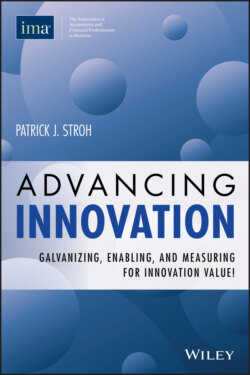Читать книгу Advancing Innovation - Patrick J. Stroh - Страница 16
На сайте Литреса книга снята с продажи.
Galvanizing, Enabling, and Measuring
ОглавлениеThink of it like exploring and mining gems in your business—not just thinking about innovation, but setting up for, executing, and measuring innovation value and then taking actions based on those measures to create even more value!
You could also think about the three elements of Innovation Elixir like a Venn diagram. At the convergence of those three elements, you obtain the value. Can you get any value in doing only one of the elements? Sure. But it won’t be systematic, repeatable, and lasting in your organization. It will be more a function of luck than enablement and leadership.
What did research respondents say was their biggest area of concern and focus for improvement with regard to innovation? Thirty-seven percent were almost equally split between galvanizing, enabling, and measuring, with a slight edge to those who wanted help in enabling. But 60% responded “all of the above,” wanting help in all three areas if they were going to be responsible and accountable for innovation value and governance in their organization. That’s smart. As the three areas were defined to them, they saw the importance of each one as well as the need to solidify their own knowledge in each area.
Part III specifically gets into the “how to” of innovation success: Chapters 6–10 describe five channels of innovation you can implement in your organizations and give you the specifics on the innovation channels. I’ll cover how to implement these channels quickly while also pointing out pitfalls to watch out for, how to measure success in the channel, and how to make it an innovation channel that endures over time. Some organizations may be more skewed to certain channels than others, but you should consider the multiple channels presented in Chapters 6–10. Determine which apply to your business and where you can drive innovation value— incremental, distinctive, and breakthrough innovations!
Part IV of the book describes the third element of the Innovation Elixir: measurement of innovation. If we can measure it, we can improve it! Measurement is important so that we can get better at innovation, get more innovation, and, therefore, drive more value. Chapters 11–13 discuss strategic business archetypes and what your firm looks most like from a business strategy standpoint.
Part IV also introduces you to Innovation Value Score® (IVS). I have a simple goal and purpose for IVS. I want everyone in the world to be more successful in their innovation endeavors and benefit from using IVS to measure their innovation results and manage their value creation. While there is no perfect singular metric to measure innovation success in all organizations, I believe IVS can serve as a start to look at the right balance of indicators, correlate those indicators to your business strategy, allow you to compare and contrast to other organizations, and, most important, take meaningful action to drive value. Keep in mind: IVS is not about just measurement; it is about overall innovation value creation and management!
Although IVS may not be perfect, it will be directionally correct—you aren’t calculating earnings per share to three decimal places, you’re looking for directional leading indicators and mile markers. It enables a meaningful dialogue and discussion around innovation within your businesses, your industries, and in local and global economies. By creating this measurement system, I wanted to enable you, my readers, to drive more value for your customers and stakeholders. You can and should look at the world like a growing pie chart in which you can continue to grow with additional value, rather than a static pie chart where everyone fights over market share. I aspire to help all businesses and organizations to drive more innovation value and realize more value! Yes, it’s a lofty goal, but it’s a worthy goal.
As you read through this book, bear in mind that I did not write this book with the intent of holding it up as new revolutionary thinking in the theory of innovation. There are plenty of luminaries out there who can speak and write extensively about innovation theory. Rather, I wrote this book to provide a “how-to” approach that enhances your practices in innovation and increases the probability of success by laying out baseline innovation information with a multitude of foundational elements from many places.
Then we can focus on the new thinking in this body of work, which is how to effectively measure innovation. If we can’t measure it, we can’t improve it. And we want a measurement system that we can compare and contrast against other organizations so that we can drive everyone’s innovation levels up, therefore increasing value in our markets.
Finally, the Appendix offers some very valuable tools that are referenced throughout the text. How often do you go to a seminar, webinar, or read a book, and you’d like to ask that author or presenter, “Can you show me an example of a form I could use to capture/evaluate/communicate the concept you just covered?” You get the concept, but can’t they just show you a template or form you could use to implement the idea? Well, in this book, the answer is YES! As you read through the chapters, you’ll see references to best practices, pros and cons, process steps, check lists, decision flows, and the like. The Appendix has an inventory of several of these documents for you to review.
